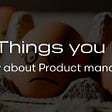Iterating Insulin: Miracle Drug
This is Part One in a series I’m calling Iterating Insulin, where I bring a Product Manager’s view to the many tools and techniques used to manage Diabetes. This section focuses on the drug itself: Insulin.
I’m Jackson: a Product Manager with Type 1 Diabetes. I was diagnosed in 2019, so the disease hasn’t been a part of my life for long. That means I can apply my Product expertise from the user’s standpoint without too many preconceived notions or existing context. I’m not a doctor and my opinions are my own.
Let’s start with the miracle drug itself…
Insulin.
Some basics. Insulin is a naturally occurring hormone produced by the pancreas to regulate blood glucose (aka sugar). Your body is great at making insulin, my body isn’t.
When you, dear reader, eat a piece of cake, the carbohydrates, both the simple sugars from the icing and the more complex carbs in the… sponge?… are broken down into glucose. The body has 2 ways of getting rid of glucose. The first is to burn it up and turn it into energy. So yeah, have a piece of cake and go run a mile, no extra insulin required.* Any leftover glucose is processed by insulin, which is produced by the pancreas in response to high blood glucose levels.
My pancreas is terrible at making insulin.
If I have a piece of cake without insulin (and I don’t run a mile), my blood glucose levels will spike to over 200 mg/dL. Prolonged time spent at these numbers has major health implications, and a particularly nasty spike can send a patient into a life-threatening hyperglycemic coma.
So, instead of relying on my shitty pancreas, I take artificial insulin.
And you know what? It works. There’s a reason Frederick Banting and John Mackleod won a Nobel Prize in 1923.
But boy is it imperfect.
The most important side effect of artificial insulin is the risk of hypoglycemia, or “going low”. Too much insulin means not enough sugar in the blood, and that too can be fatal. Hypo shock is way more common than hyper shock, and now it’s time to start thinking about insulin itself as a capital-p Product.
While I manage my highs and stave off my lows each day, I’ve surfaced 5 user pain points that insulin’s imaginary Product Manager might address. Lots of these issues have solutions already, which are super exciting. But there’s still a long way to go. (click straight through to any Pain Point or simply read on…)
Pain Point 1: Needles hurt (or are scary)
The most obvious (literal) pain point faced by a diabetic is the sheer quantity of needles in our lives. Don’t like needles? Don’t get diabetes. Or get over it. I inject myself with 24-hour “slow” insulin every night and a 2–3 hour “fast” insulin before any meal that includes even a modest amount of carbs. I try not to have carbs for breakfast, so that’s about 3 needles per day.
Opportunity: Delivery without a needle.
Lo, the smart people at MannKind developed Afrezza, a nasal delivered insulin. No more needles, and it feels like taking a nasal allergy spray. Amazing. Unfortunately, it only comes in doses of 4 units at a time(1 unit = 1/100 of 1 mL) and some folks don’t need that much. Remember hypoglycemic shock? Yeah, don’t want that. Great start, though.
Pain Point 2: The vial, the syringe, the need to refrigerate… so much equipment
If you’ve ever watched somebody inject themselves with insulin, there’s quite a lot of, well, stuff involved. It’s cumbersome to carry all these materials around, and it’s annoying to fumble with it all in a restaurant bathroom.
Opportunity: Mobile-friendly & modular insulin materials.
The solution is the insulin pen, which is an elegant, minimal tool that has won design awards. All I need is my blue Humalog pen and a needle tip and I’m good to go.
Unfortunately, pens come in one size: 3mL. That’s 300 units if you’re playing along at home. Once I start using a pen, the insulin inside has 30 days before it expires. So that’s 10 units a day.
But, I use about 5 fast-acting units in a day, so am I supposed to throw out fully half of a pen’s contents every month? Can we just make a half-pen?
Pain Point 3: Artificial “fast-acting” insulin is too slow.
I have to take insulin 15 minutes before eating in order to have it counteract the carbs coming in. If I eat too early, my sugar may spike. Too late, and I’ll go dangerously low. When would you say is the exact moment 15 minutes from eating? When I eat out, I’m judging how long the wait to be seated is, how fast the service is, are there any chips (carbs) on the table before we eat…you get the idea.
Opportunity: Faster fast insulin.
There’s a speedy new insulin on the block, called Fiasp, FDA approved in 2018. It enters the bloodstream in 2–5 minutes, peaking effectiveness around 30 minutes. You can take it after you start eating, or right at mealtime. But, users have reported that they need a lot more of the stuff because it leaves the bloodstream as quickly as it arrived. More insulin = more $$$.
Pain Point 4: Sometimes I need 2.5 units.
So one unit is 0.01mL. How many units a patient uses per meal will vary widely and some folks have more “room for error”. But why can’t we be trusted to subdivide? I can feel the difference between 2 units and 3 units, and I often realize I need 2.5…
Opportunity: Let users subdivide. A little.
I don’t think we need to go crazy, but the Unit could stand to be halved. This would have implications for the “feel” of the process. I don’t want one pen to click 3 times as I wind it up and another to click 6 times for the exact same dosage, but I wonder if there’s an elegant solution here.
Pain Point 5: Insulin is expensive af.
This one leaves the realm of Product Management and approaches policy. The US lets pharma companies set their own prices, and powerful companies like Eli Lilly have lobbied Congress to refresh their patent on insulin time and again. Banting refused to put his name on a patent and the invention was later sold to the University of Toronto for $1. Read up here and let the rage flow.
In 2016, the average out-of-pocket price per month for an insulin user was $450. Nearly 1 in 4 users have reported rationing this life-saving drug.
Opportunity: Vote for leaders who will check big pharma, provide support for patients and limit powerful lobbying interests.
Key Takeaway: A working pancreas provides just enough insulin to process sugar and maintain the blood’s equilibrium. The pancreas works with data and responds in real-time. The closer we can come to replicating this process, the better, but our insulin comes in big chunks and works slowly. That leads to under-dosing and over-correcting. There’s nothing worse than dosing, eating, going high, re-dosing, going low, binging on sugar to recover … it’s lovingly called a roller coaster in the diabetic community, but it can be dangerous, even life-threatening.
Insulin has come a long way: we have non-needle insulin, we have super fast insulin, our insulin is portable. But there’s still room for improvement. We need to pull it all together. This $40bn+ market is ready to be disrupted by an insulin that works fast, allows for safe real-time corrections, is mobile-friendly and avoids needles. Once the product is solved, we turn to policy and pricing...






